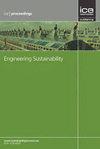评估民用基础设施可持续性和弹性的实用框架
IF 1.5
4区 工程技术
Q3 ENGINEERING, CIVIL
Proceedings of the Institution of Civil Engineers-Engineering Sustainability
Pub Date : 2021-06-01
DOI:10.1680/jensu.20.00010
引用次数: 2
摘要
土木工程领域的研究侧重于更新的思想和哲学,如可持续性和弹性(S&R)。这在制定评估民用基础设施可持续性或复原力的框架方面表现得很明显。研究人员开发了几个框架来量化民用基础设施的可持续性和弹性。显然,可持续性和复原力并不是相互排斥的,同时评估这两个方面很重要,同时评估的框架必须能够适应同时进行的评估。虽然还有其他框架遵循统一的S&R评估方法,但它们并未将危害风险作为框架的一部分加以考虑。在拟议的框架中,试图将危害的风险作为评估的一部分,以获得对危害影响的现实看法。本文提出了使用框架的明确步骤,以及在评估遭受地震和洪水两种类型灾害的土坝时使用框架的例子。这个框架的新颖之处在于它的简单性和灵活性。主要输入参数是用户定义的,这允许在确定基础设施的整体质量时考虑广泛的变量。本文章由计算机程序翻译,如有差异,请以英文原文为准。
A practical framework to assess the sustainability and resiliency of civil infrastructure
Research within civil engineering is focusing on newer ideas and philosophies such as sustainability and resiliency (S&R). This is evident in the development of frameworks to assess sustainability or the resiliency of civil infrastructure. Several frameworks were developed by researchers to quantify sustainability and resiliency of civil infrastructure. It is evident that the sustainability and resiliency are not mutually exclusive and is important to asses these aspects at the same time and frameworks be able to accommodate simultaneous assessments. While there are other frameworks that follow a unified approach to S&R assessments, they do not account for the risk of the hazard as a part of the framework. In the proposed framework, an attempt was made to include the risk of the hazard as a part of the assessment to gain a realistic perspective of the hazard impact. This paper presents explicit steps to use the framework, along with an example of using the frame work in assessing an earthen dam subjected to two types of hazards, earthquakes and floods. Novel aspects of this framework revolve around the simplicity, and flexibility of the framework. Major input parameters are user-defined, which allows for a wide range of variable to be considered when determining the overall quality of the infrastructure.
求助全文
通过发布文献求助,成功后即可免费获取论文全文。
去求助
来源期刊

Proceedings of the Institution of Civil Engineers-Engineering Sustainability
ENGINEERING, CIVIL-ENGINEERING, CIVIL
CiteScore
3.70
自引率
16.70%
发文量
44
审稿时长
>12 weeks
期刊介绍:
Engineering Sustainability provides a forum for sharing the latest thinking from research and practice, and increasingly is presenting the ''how to'' of engineering a resilient future. The journal features refereed papers and shorter articles relating to the pursuit and implementation of sustainability principles through engineering planning, design and application. The tensions between and integration of social, economic and environmental considerations within such schemes are of particular relevance. Methodologies for assessing sustainability, policy issues, education and corporate responsibility will also be included. The aims will be met primarily by providing papers and briefing notes (including case histories and best practice guidance) of use to decision-makers, practitioners, researchers and students.
 求助内容:
求助内容: 应助结果提醒方式:
应助结果提醒方式:


